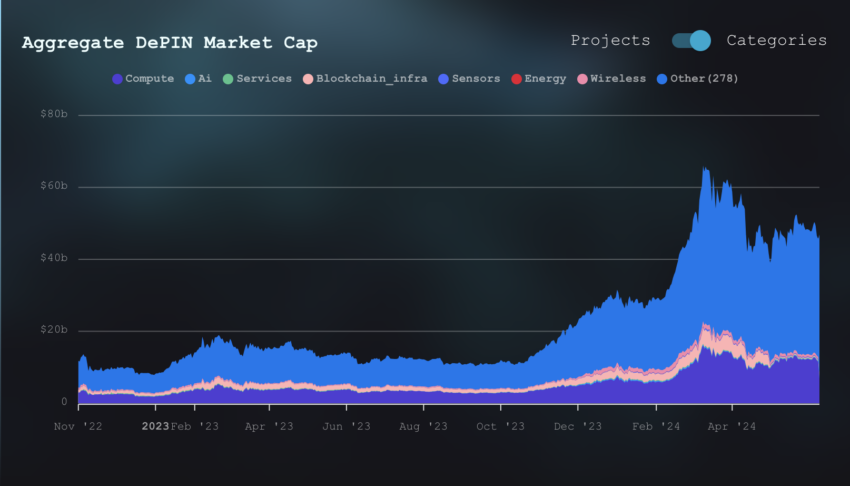
Decentralized Physical Infrastructure Networks (DePin) are transforming the tech landscape by enabling decentralized projects in real-world infrastructure.
Here’s what happened recently in the DePin sector: io.net’s CEO stepped down just before their token launch, Helium Mobile reached over 92,000 subscribers, and the number of active decentralized physical infrastructure projects grew to more than 1,200.
CEO of io.net Steps Down
Solana-based decentralized infrastructure provider io.net, which allows users to monetize their GPU power, has recently replaced its CEO just two days before the launch of its native token on Binance Launchpad. The token launch, scheduled for Tuesday, June 11, is part of io.net’s ambitious plans to become the world’s largest AI computing network. Co-founder Ahmad Shadid stepped down immediately, and fellow co-founder and former COO Tory Green stepped in as his successor.
In an effort to address speculation about his departure, Shadid has provided an explanation for his decision. He stresses that the firm remains committed to growth and success, and his departure aligns with this vision.
“While there have been allegations regarding my past, I want to emphasize that I am stepping down as CEO to allow io.net to move forward without distraction and to focus on its growth and success,” Shadid said.
Read more: 5 DePin Coins to Add to Your Portfolio in June 2024
Io.net aggregates GPU resources to create a network offering machine learning startups affordable computing power, significantly reducing costs compared to traditional cloud services. However, io.net has faced heavy criticism.
Observers argue that io.net misled the community about its GPU capabilities and question why it sets prices instead of allowing compute owners to do so. Furthermore, a GPU metadata attack on April 28 caused active GPU connections to plummet from 600,000 to 10,000, exacerbating concerns about the network’s reliability and transparency.
Helium Mobile Crosses 92,000 Subscribers
Helium Mobile now has more than 92,000 subscribers, showing the rising interest in decentralized wireless networks. Helium’s model uses blockchain technology to reward users for setting up and maintaining wireless coverage, which has attracted a large community and expanded its network.
Every time a new subscriber signs up, an NFT is minted, adding to the decentralized network’s appeal. Users can also earn MOBILE tokens by doing tasks like “Discovery Mapping,” where they share their location to help improve coverage. These tokens can pay for their phone plans or be traded for other cryptocurrencies.
Read more: Top 8 Helium (HNT) Wallets to Consider in 2024
Helium Mobile offers a $20 per month plan for unlimited talk, text, and data. It uses both the Helium network and T-Mobile’s infrastructure to provide coverage. This combination, along with strong community support and smart strategies, shows how successful decentralized models are becoming in telecommunications.
The Number of Active DePin Projects Surpassed 1,200
The DePin ecosystem is flourishing, with 1,215 active projects currently underway, a total market cap of $47 billion, and an annual revenue run rate of $15 million, according to the DePin Ninja dashboard.
Projects range from decentralized wireless networks to community-driven energy grids, showcasing the diverse applications of DePin technologies. The top five by market cap include Fetch.ai ($4.3 billion), Render ($3.56 billion), Filecoin ($3.3 billion), The Graph ($2.5 billion), and Arweave ($2.5 billion).
Read more: Top 9 Web3 Projects That Are Revolutionizing the Industry

These developments point to a promising future for DePin, with rising user engagement and a growing number of active projects paving the way for decentralized solutions across various infrastructure sectors. Although DePin is still in its early stages and has several flaws, it enables the exchange of tokens between synthetic and real-world assets. This complements traditional infrastructure by providing last-mile coverage in areas where conventional models are not economically feasible.
Disclaimer
In adherence to the Trust Project guidelines, BeInCrypto is committed to unbiased, transparent reporting. This news article aims to provide accurate, timely information. However, readers are advised to verify facts independently and consult with a professional before making any decisions based on this content. Please note that our Terms and Conditions, Privacy Policy, and Disclaimers have been updated.





Be the first to comment